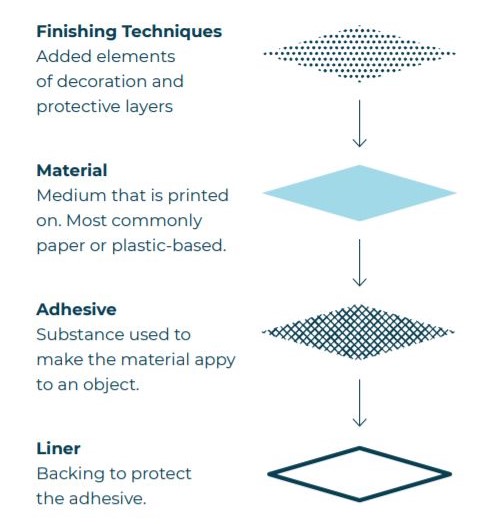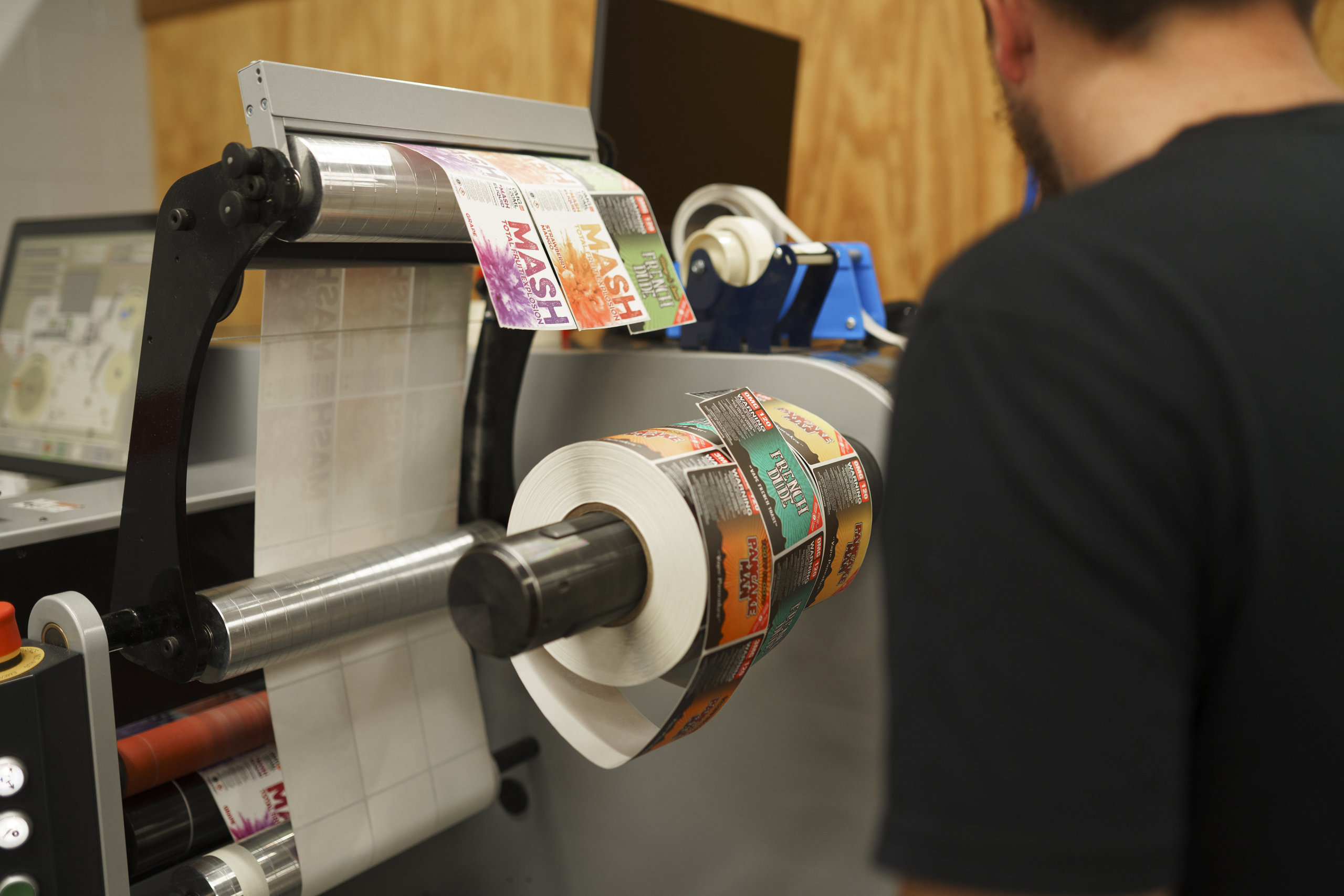What is a Release Liner and How Does It Impact Your Label?
⚞ The Highlights:
- A release liner is the backing that protects your label’s adhesive until you’re ready to apply it
- The material and silicone coating of the liner affect how smoothly the label releases and adheres to a surface
- Choosing the right release liner for your adhesive can help prevent issues like residue and misalignment during application
There’s more to your labels than what your customers see. Every label is made up of multiple components that play a specific role. While most consumers will see your label material or decorative elements, there’s one key component that makes sure your labels get to where they need to go: the release liner.
What is a Label Release Liner?
To get to the bottom of a release liner’s meaning and role, it’s important to understand how a label is constructed. These are the four main layers of a label from top to bottom.

As you can see, the release liner serves as the base layer for any roll of pressure sensitive labels. This release liner is a thin sheet with a silicone layer that allows adhesive to release the roll so that it can be applied to another surface. If it weren’t for the release liner, also known as a carrier, your labels would simply stick to each other or something else before you could transport it to the next application.
The Different Types of Release Liners
Like label materials, there are different types of release liners available for use. Each of these carriers have different advantages depending on your applicator and other product factors. While there are a variety of options, there are three types of release liners that are common for product labels.
- PET (polyester)
- Calendered Kraft paper
- Polykraft paper
PET release liners
A PET release liner is made with polyester film to create a carrier that’s extremely smooth. A major advantage of PET release liners is that they don’t break as easily as a paper liner. That strength makes PET release liners a great choice for high-speed applicators.
Another benefit of PET release liners is that they’re great for wet applications. For example, beer cans are typically soaking wet by the time they reach the labeling line, so that added durability is a major positive for any adverse applicating environments. PET is also thinner than the usual release liner papers. As such, a standard 1.2 mm PET release liner will allow you to get more labels on a roll and take up less space during shipping and storage.
Calendered kraft paper release liners
While film release liners have their advantages, paper carries are still extremely common for labels in multiple industries. Super calendered kraft (SCK) papers are typically bleached white and are commonplace in the U.S. as many applicators are made to accommodate papers.
The reason why businesses commonly turn to SCK release liners extends beyond paper being an old standby for label carriers. A paper being “calendered” means that it’s polished, so an SCK is smoother than regular paper liners. That smoothness and the ability to work with the majority of applicators makes SCK a go-to option for product labels.
Polykraft release liners
A polykraft release liner is essentially a mid-point between PET and paper label carriers. Polykraft is a brown, unbleached paper that’s a little thicker and heavier than standard kraft papers. This extra heft and thickness is because polykraft has a very thin layer of polypropylene married to the paper.
The advantage of Polykraft is that the layer of polypropylene makes the material more stable and sturdy. These qualities help with moisture barriers while still allowing companies to invest in paper liners. As such, Polykraft is typically used in wine labeling and other industries that are used to paper release liners, but still need that added stability to deal with moisture.

How to Identify the Right Label Release Liner
While there are multiple label release liners available, there are a few different factors that can impact which one is best for your needs. To identify the right carrier for your labels, you’ll want to weigh the following considerations.
Your label applicator
The biggest factor in which release liner you should use depends on how you’re going to apply those labels. An applicator reads the gap between labels to know when the applicator should dispense a label. Once the sensor reads a gap, it will dispense a label so that it catches a can, bottle, or any other container. However, the wrong release liner can lead to label application issues.
Simply put, some applicators aren’t made to read clear liners. New applicators are built to accept clear release liners, which means PET carriers shouldn’t pose problems. However, you would need to opt for SCK, Polykraft, or some other opaque release liner if your application process isn’t made to handle clear carriers.
Environmental factors
The applicator isn’t the only potential challenge during the application process. You also need to make sure your release liner works with your applicating conditions.
Different application environments pose certain problems for your release liners. Wet conditions are the biggest issue, especially for paper carriers. If a beer can or some other container is soaking wet, that can cause carriers without enough moisture resistance to tear. As such, you’ll need to invest in a PET release liner or another solution that can hold up to your applicating environment.
Clear labels
Some liner issues are less obvious than others. While the carrier is removed before your labels are applied, it can still have a visual impact on clear labels if you’re not careful.
If you want to use clear labels, its best to use some form of film release liner. The reason for this is that running a clear label on a paper liner can make the label look cloudy. This cloudiness occurs because the label adhesive takes the shape of the carrier. Even a super calendered paper has small fibers that can impact the adhesive. Because of this, it’s best to use a PET release liner that has no imperfections and will enable true clarity.
Invest in the Perfect Labels from Top to Bottom
While they don’t end up on your products, different types of release liners play a pivotal part for your labels. That’s why Blue Label strives to provide the perfect labeling solution for your products. Our experts work with you to uncover any opportunities and potential issues to make sure every layer of your label is perfect for your needs.
Ready to invest in the right labels for your products? Contact us today to talk about your next label project.